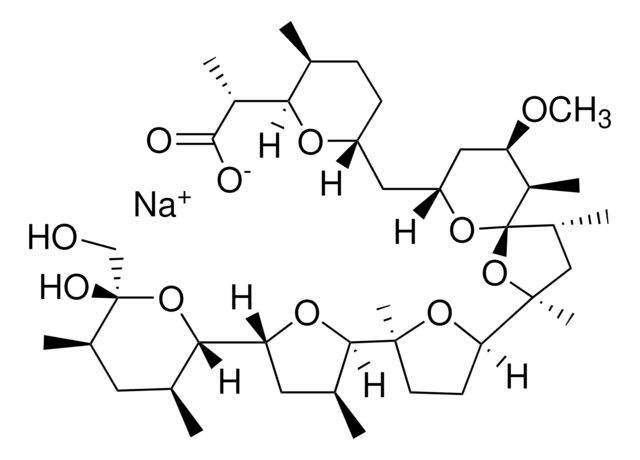P0543
5-Pregnen-3β-ol-20-one-16α-carbonitrile
≥97%
Sinônimo(s):
Pregnenolone-16α-carbonitrile
About This Item
Produtos recomendados
fonte biológica
synthetic (organic)
esterilidade
non-sterile
Ensaio
≥97%
forma
powder, crystals or chunks
técnica(s)
cell culture | mammalian: suitable
solubilidade
chloroform: methanol (1:1): 50 mg/mL, clear, colorless to faintly yellow (with heat)
Condições de expedição
ambient
temperatura de armazenamento
2-8°C
cadeia de caracteres SMILES
C[C@@]12[C@](C[C@@H](C#N)[C@@H]2C(C)=O)([H])[C@]3([H])CC=C4C[C@@H](O)CC[C@]4(C)[C@@]3([H])CC1
InChI
1S/C22H31NO2/c1-13(24)20-14(12-23)10-19-17-5-4-15-11-16(25)6-8-21(15,2)18(17)7-9-22(19,20)3/h4,14,16-20,25H,5-11H2,1-3H3/t14-,16-,17+,18-,19-,20-,21-,22-/m0/s1
chave InChI
VSBHRRMYCDQLJF-ZDNYCOCVSA-N
Aplicação
- in the induction of cytochrome P450
- as pregnane X receptor (PXR) activator in human liver cell lines.
Ações bioquímicas/fisiológicas
Código de classe de armazenamento
11 - Combustible Solids
Classe de risco de água (WGK)
WGK 3
Ponto de fulgor (°F)
>199.9 °F - closed cup
Ponto de fulgor (°C)
> 93.3 °C - closed cup
Equipamento de proteção individual
Eyeshields, Gloves, type N95 (US)
Certificados de análise (COA)
Busque Certificados de análise (COA) digitando o Número do Lote do produto. Os números de lote e remessa podem ser encontrados no rótulo de um produto após a palavra “Lot” ou “Batch”.
Já possui este produto?
Encontre a documentação dos produtos que você adquiriu recentemente na biblioteca de documentos.
Os clientes também visualizaram
Nossa equipe de cientistas tem experiência em todas as áreas de pesquisa, incluindo Life Sciences, ciência de materiais, síntese química, cromatografia, química analítica e muitas outras.
Entre em contato com a assistência técnica









